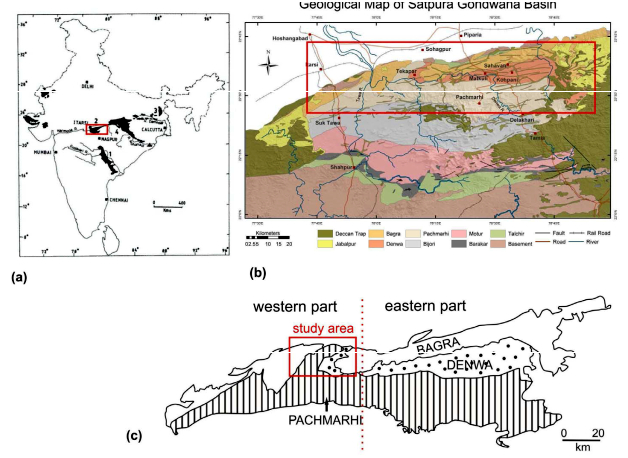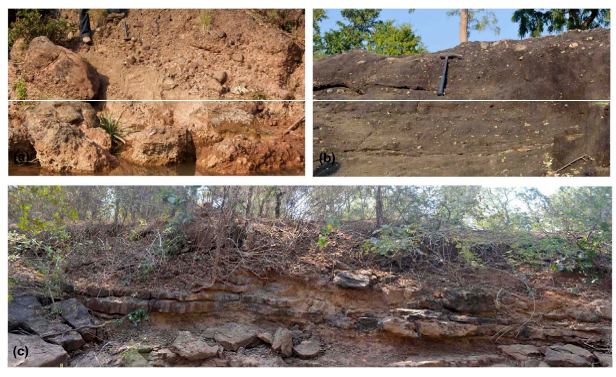Bagra Fm
Type Locality and Naming
Satpura Basin: Medlicott (1873) named the conglomerate overlying the Denwa Fm after the old Fort at Bagra, in Satpura area, Madhya Pradesh as Bagra Conglomerate. Subsequently Raja Rao (1983) referred it as Bagra Formation. Type area for Bagra Formation is Bagra Fort area at the mouth of Tawa gorge, Hoshangabad district, Madhya Pradesh. [Original Publication: Medlicott, H. B., 1873. Notes on the Satpura coal basin. Mem. Geol. Surv. Ind., 10 (1), 1-188.; Raja Rao, C.S. 1983. Coalfields of India Vol-III, Coal resources of Madhya Pradesh and Jammu and Kashmir. Bull. Geol. Surv. India, 45, 204.]
[Figure 1: a) Map of India showing Gondwana basins of the peninsular India with the red rectangle marking the Satpura Basin (after Bandyopadhyay, 1999); b) Geological map of the Satpura Gondwana Basin with the red rectangle showing the Upper Gondwana formations (after Ghosh et al., 2012); c) Geological map of the Upper Gondwana formations of the Satpura Gondwana Basin) (after Sengupta et al., 2016)]
Lithology and Thickness
Conglomerate. The Bagra Formation largely comprises of conglomerate with frequent bands of calcareous sand, pebbly sandstone, variegated clay, limestone and dolomite. The conglomerate contains clasts of banded jasper, sandstones and metamorphic rocks in a red matrix of sandy clay. At places, the formation contains lenticular bands of limestone which, according to Crookshank (1936) are of secondary origin. The formation is about 180-240 m thick.
[Figure 2: a) Conglomerate sandstone alternation in the Bagra Formation near Dhundhadehi; b) Coarse grained pebbly sandstones in the Bagra Formation near Pathai village; c) Sheet like sandstone bodies interleaved with palaeosol in the Bagra Formation near Sahra village (after Sengupta et al., 2016)]
Relationships and Distribution
Lower contact
The Bagra Formation overlies Denwa Fm with an angular unconformity (Casshyap et al., 1993).
Upper contact
The Bagra Formation is conformably overlain by the Jabalpur Fm.
Regional extent
Satpura Basin: The Bagra Formation is exposed along the northern border of the Gondwana outlier between Datadongri and Budhani, with few outcrops in the Morand Valley, Anjan gorge, above Fatehpur, around Kaveli, Mohpani.
GeoJSON
Fossils
Cotter (1917) reported amphibian Mastodonsaurua indicus while Crookshank (1936) recorded two imperfect casts of gastropod shells from Bagra Formation. Presence of a diplodocid sauropod was mentioned by Chatterjee and Scotese (1999).
Age
Depositional setting
Casshyap et al. (1993) interpreted this formation as an alluvial fan system on the basis of coarse-grained nature of sediments, upward fining distribution, lateral changes in gross lithology and stratification types. The paleocurrent data suggest that the sediment transport of this formation was mostly from NNE to SSW direction.
Additional Information
References
Bandyopadhyay, S. (2011) Non-marine Triassic vertebrates of India. In: J.O. Calvo, J. Porfiri, B. Gonzalez Riga, and D. Dos Santos (Eds.), Paleontología y dinosaurios desde América Latina. EDIUNC, Editorial de la Universidad Nacional de Cuyo, Mendoza, Argentina, pp.33-46. Bandyopadhyay, S. And Sengupta, D.P. (2006) Vertebrate faunal turnover during the Triassic-Jurassic Transition: An Indian Scenario. New Mexico Museum of Nat. Hist. and Sci. Bull., 37, 77-85. Casshyasp, S.M., Tewari, R.C. and Khan, A. (1993). Alluvial fan origin for Bagra Formation (Mesozoic Gondwana) and tectono-stratigraphic implications. Jour. Geol. Soc. India, 42, 262-279. Casshyasp, S.M., Tewari, R.C. and Khan, A. (1993). Alluvial fan origin for Bagra Formation (Mesozoic Gondwana) and tectono-stratigraphic implications. Jour. Geol. Soc. India, 42, 262-279. Chatterjee S. & Scotese C.R. (1999). The breakup of Gondwana and the evolution and biogeography of the Indian plate: Proceedings of the Indian National Science Academy, 65A, 397–425. Cotter (1917 Crookshank, H. (1936) Geology of the northern slopes of the Satpuras between the Morand and the Sher Rivers. Mem. Geol. Surv. India, 66(2), 217-218. Medlicott, H. B., 1873. Notes on the Satpura coal basin. Mem. Geol. Surv. Ind., 10 (1), 1-188. Raja Rao, C.S. 1983. Coalfields of India Vol-III, Coal resources of Madhya Pradesh and Jammu and Kashmir. Bull. Geol. Surv. India, 45, 204.

